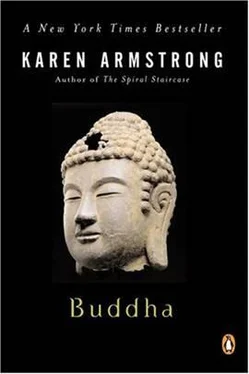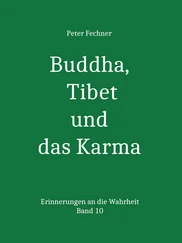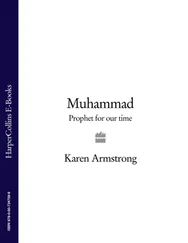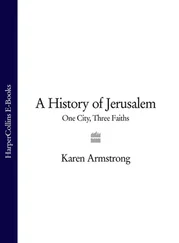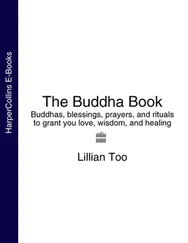In the early days, many had adopted this special ajiva vocation chiefly to escape from the drudgery of domesticity and a regular job. There were always some renouncers who were chiefly dropouts, debtors, bankrupts and fugitives from justice. But by the time Gotama embarked on his quest, they were becoming more organized and even the most uncommitted monks had to profess an ideology that justified their existence. Hence a number of different schools had developed. In the efficient new kingdoms of Kosala and Magadha, the government had begun to exercise more control over the inhabitants and would not allow people to embrace an alternative lifestyle that made no contribution to society as a whole. The monks had to prove that they were not parasites, but philosophers whose beliefs could improve the spiritual health of the country.
Most of the new ideologies centered on the doctrine of reincarnation and kamma: their object was to gain liberation from the ceaseless round of samsara that propelled them from one existence to another. The Upanisads had taught that the chief cause of suffering was ignorance: once a seeker had acquired a deep knowledge of his true and absolute Self (atman), he would find that he no longer experienced pain so acutely and have intimations of a final release. But the monks of Magadha, Kosala and the republics to the east of the Gangetic plain were more interested in practicalities. Instead of regarding ignorance as the chief cause of dukkha, they saw desire ( tanha ) as the chief culprit. By desire they did not mean those noble yearnings that inspired human beings to such inspiring and elevating pursuits as the holy life, but the type of craving that makes us say “I want.” They were very worried by the greed and egotism of the new society. They were, as we have seen, men of their time and had imbibed the ethos of individualism and self-reliance that was emerging in the marketplace, but, like the other sages of the Axial Age, they knew that egotism could be dangerous. The monks of the eastern Ganges were convinced that it was this thirsty tanha that kept people bound to samsara. They reasoned that all our actions were, to an extent, inspired by desire. When we found that we wanted something, we took steps to get it; when a man lusted for a woman, he took the trouble to seduce her; when people fell in love, they wanted to possess the beloved and clung and yearned compulsively. Nobody would bother to do an arduous and frequently boring job in order to earn a living unless he or she wanted material comforts. So desire fueled people’s actions ( kamma ) , but every single action had long-term consequences and conditioned the kind of existence the person would have in his or her next life.
It followed that kamma led to rebirth; if we could avoid performing any actions at all, we might have a chance of liberating ourselves from the cycle of new birth, suffering and re-death. But our desires impelled us to act, so, the monks concluded, if we could eliminate tanha from our hearts and minds, we would perform fewer kamma. But a householder had no chance of ridding himself of desire. His whole life consisted of one doomed activity after another. It was his duty as a married man to beget offspring, and without some degree of lust, he would not be able to sleep with his wife. Unless he felt a modicum of greed, he could not engage in trade or industry with any success or conviction. If he was a king or a ksatriya, he would be quite unable to govern or wage war against his enemies if he had no desire for power. Indeed, without tanha and the actions ( kamma ) that resulted from it, society would come to a halt. A householder’s life, dominated as it was by lust, greed and ambition, compelled him to activities that bound him to the web of existence: inevitably, he would be born again to endure another life of pain. True, a householder could acquire merit by performing good kamma. He could give alms to a bhikkhu, for example, and thus build up a reserve of credit that could benefit him in the future. But because all kamma were limited, they could only have finite consequences. They could not bring the householder to the immeasurable peace of Nibbana. The best that our kamma could do for us was to ensure that in the next life we might be reborn as a god in one of the heavenly worlds, but even that celestial existence would come to an end one day. Consequently, the endless round of duties and responsibilities that made up a householder’s life became a symbol of samsara and of exclusion from holiness. Tied to this treadmill of fateful activity, the householder had no hope of liberation.
But the monk was in a better position. He had given up sex; he had no children or dependents to support, and need not do a job or engage in trade. Compared with the householder, he enjoyed a relatively action-free life. But even though he performed fewer kamma, the monk still experienced desires which tied him to this life. Even the most committed monk knew that he had not liberated himself from craving. He was still afflicted by lust, and still yearned occasionally for a little comfort in his life. Indeed, deprivation sometimes increased desire. How could a monk liberate himself? How could he gain access to his true Self and free it from the material world, when, despite his best endeavors, he still found himself hankering for earthly things? A number of different solutions emerged in the main monastic schools. A teacher developed a dhamma, a system of doctrine and discipline, which, he believed, would deal with these intractable difficulties. He then gathered a group of disciples, and formed what was known as a sangha or gana (old Vedic terms for tribal groupings in the region). These sanghas were not tightly knit bodies, like modern religious orders. They had little or no common life, no formal rule of conduct, and members came and went as they chose. There was nothing to stop a monk from dropping his teacher as soon as he found a more congenial dhamma, and the monks seemed to shop around to find the best teacher they could. It became customary for the bhikkhus to hail one another on the road, asking: “Who is your teacher? And which dhamma do you follow?”
As Gotama traveled through Magadha and Kosala, he himself would probably have called out to passing monks in this way, because he was looking for a teacher and a sangha. Initially, he might have found the clash of ideologies confusing. The sanghas were competitive and promoted their dhammas as aggressively as merchants pushed their wares in the marketplace. Zealous disciples may well have called their teachers “Buddhas” (“Enlightened Ones”) or “Teacher of Gods and Men.” As in the other Axial countries, there was a ferment of debate, much sophisticated argument and a great deal of public interest in the issues. The religious life was not the preserve of a few eccentric fanatics, but was a matter of concern to everybody. Teachers debated with one another in the city halls; crowds would gather to hear a public sermon.Lay people took sides, supporting one sangha against the others. When the leader of one of the sanghas arrived in town, householders, merchants and government officials would seek him out, interrogate him about his dhamma, and discuss its merits with the same kind of enthusiasm with which people discuss football teams today. The laity could appreciate the finer points in these debates, but their interest was never theoretical. Religious knowledge in India had one criterion: did it work? Would it transform an individual, mitigate the pain of life, bring peace and hope of a final release? Nobody was interested in metaphysical doctrine for its own sake. A dhamma had to have a practical orientation; nearly all the ideologies of the forest-monks, for example, tried to mitigate the aggression of the new society, promoting the ethic of ahimsa (harmlessness), which advocated gentleness and affability.
Читать дальше
